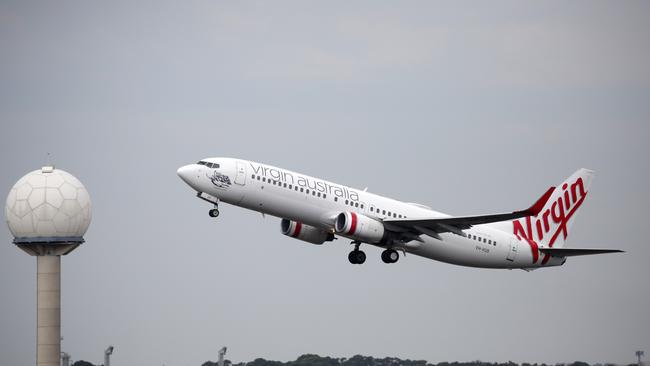Virgin’s tough new pilot
The honeymoon is over for Virgin and its new buyer, with the harsh reality of its new union setting in and some tough decisions looming in the near future, writes Terry McCrann.

Terry McCrann
Don't miss out on the headlines from Terry McCrann. Followed categories will be added to My News.
Well, that’s a surprise — foreign vulture investor Bain didn’t put up more than a $1bn of its own money and assume the risk of a couple of billion more, just to play sugar daddy to Virgin CEO Paul Scurrah and around half of the Virgin employees.
In June and even as recently as August Bain was 100 per cent behind Scurrah and keeping Virgin 2.0 as a smaller version of the full-service competitor to Qantas that was the Virgin 1.0 of both Scurrah and his predecessor John Borghetti — tiered cabin classes, lounges, international network and all.
But that was when Bain needed the support of Scurrah and the votes of the Virgin staff-creditors to seal its acquisition of the airline, and when there was still some blue sky on the aviation horizon.
Now in October when the deal is done and dusted, and the aviation sky is pretty well clouded over, it’s an old-is-new again CEO in Jayne Hrdlicka and a much more ambivalent but unmistakably hard-edged approach to costs in Virgin 2.0.
Hrdlicka’s words were very carefully chosen as she figuratively walked in the CEO’s office door: no specific reference to structure or strategy; just platitudes and generalities.
She talked of Virgin’s “unique culture” that I’ll “protect and build”. We’ll reinvigorate its “strong brand and its passion for customer service”. And not to forget, there’s the “diversity, talent and strength of its people”.
What she was really saying was that all bets — and implied promises — were off. Very simply, frankly and brutally, I’m here to do a job — to structure and run an airline to make a profit for its investors.
And that’s an investor that is not inclined to be satisfied with “bank interest” — even when “bank interest” wasn’t just barely above zero.
Bain will be aiming — the correct word now is “hoping” — for a return above 10 per cent. It will first structure Virgin 2.0 with that ambition and then run it to get the revenue and, crucially, costs to (try to) achieve it.
What it might genuinely have, though it could do in June or even as recently as August — aircraft numbers, staff numbers, cost centres like lounges — has well and truly evaporated in October, to say nothing of what happens into 2021 if the planes still can’t fly.
The key point is that Virgin’s costs are now Bain’s costs — up until this point they’ve been mostly the creditor’s costs.
Actually in both cases they’ve also been shared by the taxpayer — because of the money flowing into Virgin and on to employees under JobKeeper.
As JobKeeper is progressively reduced down to its end-March termination point, the costs switch progressively entirely to Bain.
If it can’t get the revenue because borders stay closed, what do you think it’s going to do: just absorb the costs?
I’m sure that Hrdlicka will seek to cut them while protecting and building Virgin’s unique culture and embracing the diversity, talent and strength of its people.

